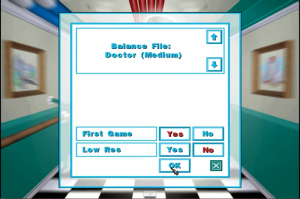GAME CHOSEN FOR ANALYSIS![]()
DESCRIPTION
Theme Hospital is a business simulation game developed by Bullfrog productions and published by Electronic Arts in 1997 that tests your management skills. It is the thematic successor to Theme Park, which is also produced by Bullfrog, and was recently made free for download for the period of January 2015. The game is set in a hospital and requires players to complete levels by buying and placing rooms or facilities in the hospital with the end goal of raising its financial valuation, cure rate and reputation.
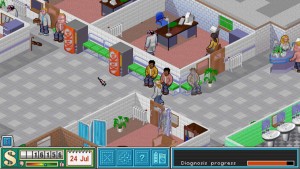
DOWNLOAD
https://www.origin.com/en-sg/store/buy/theme-hospital-origin/pc-download/base-game/standard-edition
ANALYSIS
Lens 1: Essential Experience
One experiences, from playing Theme Hospital, how it is to be a hospital administrator responsible for the day-to-day operation of a hospital. Duties include the recruitment and training of healthcare professionals (doctors and nurses), directing research and planning of the hospital layout and expansion. It is constant battle between managing the now and present (investing more resources to better the current situation, e.g. assigning all hired doctors to working the diagnosis and treatment rooms) and planning for the future (e.g. assigning some of the doctors to doing research and sending some for training).
Lens 2 & 3: Surprise and Fun
+ Permeated by an eccentric sense of dark humor, Theme Hospital is full of funny stuff that makes it surprising and fun. For example, an in-game development may be the discovery of the condition, Bloaty Head, which as the game explains, requires that the patient’s head be popped and re-inflated. There are also other constant game developments that help to occupy the player, e.g. sudden disasters such as earthquakes can cause machine explosions and research can open up new unexpected in-game technology such as better x-rays, better cures and video games for the employees. Another superbly fun element of the game is its graphical and musical design (see lens 7: aesthetics). There are also at least 34 different funny CGI full motion video endings when one loses a level.
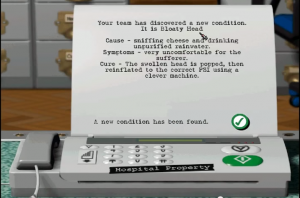
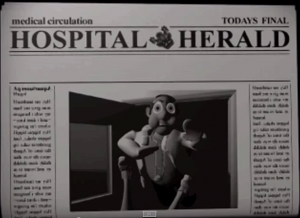
Supporting evidence during the observation of a friend’s gameplay:
- Enjoyed the humor (“Yeah, that sounds like a symptom…, lol”)
- Loved the music (“That music, that music, ha! Love it!”)
- Had fun imitating funny accents e.g. receptionist’s announcements (“general diagnosis… !”)
– The humor can get old quick as plyers progress through the levels. The initial fresh struggle at the start of a new level is relatively boring and unsurprising. It is trickier and more challenging but the game development remains largely similar; you rediscover the same old conditions you have discovered before in previous levels and you start to anticipate, dread and hate the imminent earthquakes.
Lens 4: Curiosity
+ Theme Hospital allows players decent room for free movement: (1) upon achieving a level’s victory condition, players are given a choice to stay or continue (accept or decline offer to move to a different hospital where one has to start from scratch); (2) players can choose to adopt a variety of personal goals, e.g. finishing the level as quickly as possible, training all doctors to becoming the best that they can be, building the most space-efficient hospital and winning the level with no deaths; (3) no restrictions on hospital design layout beyond the rooms’ lower size limit.
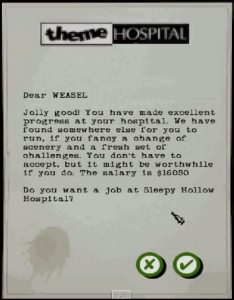
– Emergent experiences are few, if not entirely impossible. Everyone appears well-scripted and there does not seem to be room for unexpected interactions.
Lens 5: Endogenous Value
Theme Hospital’s endogenous value lies in its leveling hierarchy and many other little achievements, which may or may not be contributive to the final achievement of the victory condition, from curing patients to room and hospital design: “Yeah, I cured my first patient!!!”, “I am going to build a big comfortable staff room for my doctors!”, “No one should have to stand in my hospital!!!”. These various observations – of a pretty and well-reputed hospital – allow one to feel proud of oneself. There is also a great sense of achievement and fulfilment when one manages to succeed a level.
Lens 6: Problem Solving
In order to win the game, the player needs to raise the hospital’s reputation (by keeping the patients happy), increase the cure rate (by upgrading the hospital) and earn a lot of money (a natural consequence of the above two). This requires strategic problem solving; how should I allocate the limited resources I have right now? There has to be a good balance for the eventual achievement of the victory condition; kill too many patients or incur too much debt and you will lose the game.
Lens 7: Elemental Tetrad – Aesthetics, Mechanics, Story, Technology
Aesthetics
+ Theme Hospital has relatively simplistic graphics. Originally released with a 640 x 480 resolution, it is not exactly imbued with the WOW factor. Despite so, the cartoonish (and yet not unpolished!) and well-animated graphics has its own undeniable appeal. The sound effects are also amazing with a huge variety and great quality; there are different sound clips for the dispense of different drinks and for the different treatments, e.g. the popping of a patient’s head, and various different regular motions such as the opening and closing of doors. This greatly enhances the overall taste of the game.
(An additional open source mod for Theme Hospital, CorsixTH, enables full HD graphics at the expense of certain minor game features, e.g. vomiting patients in the hallways and earthquakes. It also enables a Free Build mode!)
Mechanics
The game rules are few and simple, to the point that instructions are more or less superfluous. In a word, in order to win, make good decisions and build a brilliant hospital that outshines all the other hospitals in the game (AI or other players in a network session). The game mechanics are hence, largely limited to the following: leveling, designing and arranging. For players who prefer games with more thrills and action, games with more focus on physical motion rather than strategic planning, Theme Hospital is likely to fall flat as a largely boring game.
+- This is both an advantage and a disadvantage. Simple game rules equate to less inertia and a higher game adoption rate, but are also more likely to result in boredom.
Story
There is no deep storyline to Theme Hospital. In essence, the user is given a hospital to build and manage from scratch. Conflict arises from the competition with other hospitals in the area. The final resolution is a black-and-white win or lose situation. There is little, if any, tension between storytelling (author control) and interaction (player control). The player is given free play and control for most, if not the entirety, of the game. Once again, this can quickly cause boredom. On the other hand, for such management games, a deeper storyline is usually superfluous. A deeper and more detailed background story may or may not help in engaging the players; in fact, players may find a narrative irritating as they just want to ‘get on with it’.
Technology
Theme Hospital is an old game with minimal system requirements. It does not make use of any cool and recent gaming technology. All it requires is a mouse: point, click and select, that’s all you need to do. In this sense, Theme Hospital is not ‘fresh’ (although the graphics can be considered refreshing in this modern era of realistic-over-simplistic game design).
Lens 8: Challenge
+ As the level gets more difficult, the victory condition gets more and more elusive. Yet, it always seems entirely reachable. This arouses in the player a strong desire to keep on until the level is complete. A few losses do nothing to dampen the spirits. The frustration simply serves as further motivation to keep trying. As such, Theme Hospital has found an excellent balance point. Also, once all 12 levels on the easy mode are completed, there are still the medium and hard modes to conquer.

